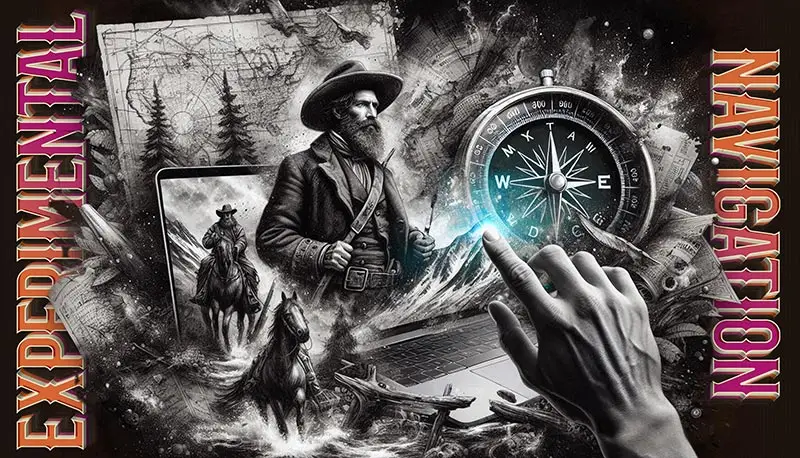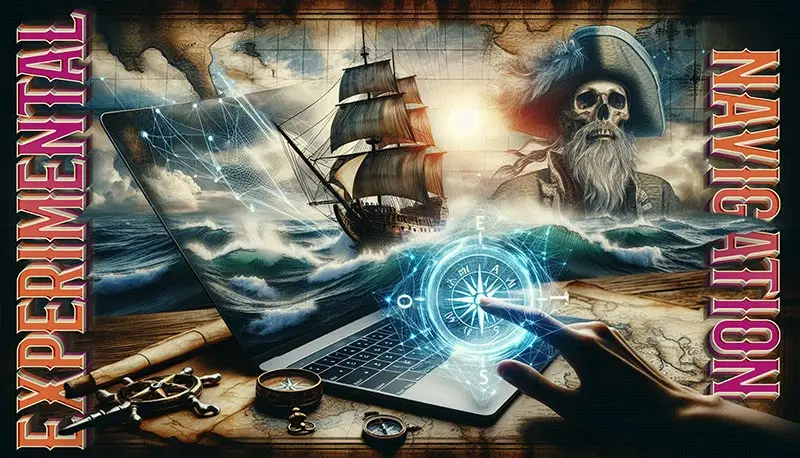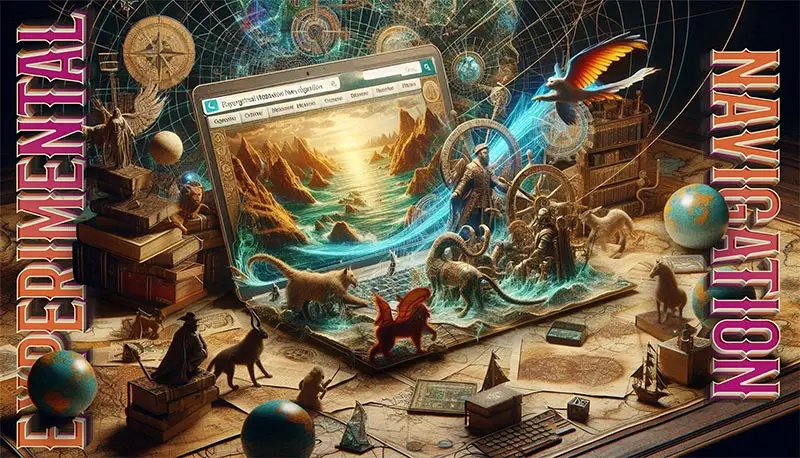
Enhance Your Website Layout with Experimental Navigation Design Elements

Unlocking the Potential of Experimental Navigation: Enhancing Your Website Layout with Design Elements
Learn the importance of incorporating innovative navigation features to improve user experience
In the ever-evolving world of web design, experimental navigation has become a popular trend for enhancing website layouts. By incorporating unique and innovative design elements, web designers are able to create more engaging and user-friendly experiences for visitors. From unconventional menu structures to interactive scrolling features, experimental navigation offers a fresh approach to guiding users through a website. In this article, we will explore the various design elements that can be used to enhance website layouts and provide a more seamless navigation experience for users. Whether you're a seasoned web designer or just starting out, understanding these design elements can help you create a more dynamic and visually appealing website.


experimental navigation encourages us to think outside the box and embrace the unknown
What is Experimental Navigation?
Experimental navigation is the process of exploring new and innovative ways to navigate through the world around us. It involves stepping outside of traditional methods and embracing a spirit of curiosity and adventure. Whether it's finding your way through a new city, navigating a challenging hiking trail, or even charting a course through life, experimental navigation encourages us to think outside the box and embrace the unknown.
So, what does experimental navigation look like in practice? Here are a few key aspects to consider:
- Exploration: Experimental navigation is all about exploring new paths and possibilities. It's about being open to trying new things and taking the road less traveled.
- Creativity: It requires thinking creatively and problem-solving on the go. It's about finding unique solutions to navigate through challenges and obstacles.
- Flexibility: Experimental navigation means being adaptable and open to change. It's about being willing to adjust your course as you learn and grow.
- Courage: It takes courage to embrace experimental navigation. It means stepping out of your comfort zone and taking risks in order to discover new and exciting possibilities.

When it comes to creating a successful website, navigation is key
Ultimately, experimental navigation is about embracing a mindset of exploration and discovery. It's about being open to new experiences and finding joy in the journey. So, the next time you find yourself facing a new challenge, consider approaching it with a spirit of experimental navigation. Who knows what amazing discoveries you might make along the way!

What Type of elements does Experimental Navigation consist of on a website?
The Elements of Experimental Navigation on a Website
When it comes to creating a successful website, navigation is key. It's the roadmap that guides users through your site and helps them find what they're looking for. But what if you want to take your website's navigation to the next level? That's where experimental navigation comes in. This innovative approach to website design can help you stand out from the crowd and create a truly unique user experience. So, what type of elements does experimental navigation consist of on a website? Let's explore.
- Interactive Menus: Traditional drop-down menus are a thing of the past. Experimental navigation often includes interactive menus that engage users and encourage exploration. This could involve animated transitions, hidden navigation elements, or even a non-linear menu structure.
- Scrolling Effects: Instead of static navigation bars, experimental websites may incorporate scrolling effects that change the navigation as users move down the page. This can create a dynamic and immersive experience that keeps users engaged.
- Custom Transitions: Experimental navigation often includes custom transitions between pages or sections of a website. This could involve animated effects, parallax scrolling, or other creative techniques that make the navigation feel seamless and intuitive.
- Non-Traditional Navigation Elements: In addition to traditional links and buttons, experimental navigation may incorporate non-traditional elements such as images, videos, or even interactive elements like sliders or carousels. This can make the navigation more visually engaging and memorable.
- User-Driven Navigation: Instead of a one-size-fits-all approach, experimental navigation may be tailored to individual users based on their behavior, preferences, or past interactions with the website. This could involve personalized recommendations, adaptive menus, or other user-driven navigation elements.

experimenting with new and innovative design elements can take user experience to the next level

By incorporating these elements into your website's navigation, you can create a truly unique and memorable user experience. Whether you're looking to stand out from the competition, engage your audience in new ways, or simply make your website more intuitive and user-friendly, experimental navigation can help you achieve your goals. So, don't be afraid to think outside the box and experiment with new and innovative navigation techniques. Your users will thank you for it!
How Experimental Navigation Design Elements Can Improve User Experience on a Website
When it comes to designing a website, user experience is paramount. The way users navigate through a website can greatly impact their overall experience. Traditional navigation elements such as menus and buttons are essential, but experimenting with new and innovative design elements can take user experience to the next level. Here are some ways experimental navigation design elements can improve user experience on a website:
- Enhanced Engagement: By incorporating experimental navigation design elements such as interactive animations or unique scrolling effects, users are more likely to be engaged and spend more time exploring the website. These elements can create a sense of novelty and surprise, making the user experience more enjoyable and memorable.
- Improved Accessibility: Experimental navigation design elements can also improve accessibility for users with disabilities. For example, implementing voice-controlled navigation or gesture-based interactions can make the website more inclusive and user-friendly for individuals with limited mobility or visual impairments.
- Personalized Experience: Dynamic navigation design elements, such as personalized recommendations or customized pathways based on user behavior, can create a more tailored and personalized experience for each user. This can lead to higher user satisfaction and increased engagement with the website.
- Efficient Information Retrieval: Experimenting with unconventional navigation design elements can also help users find information more efficiently. For instance, implementing a visual search feature or utilizing augmented reality for navigation can streamline the process of locating specific content on the website.
- Brand Differentiation: Innovative navigation design elements can set a website apart from its competitors and reinforce the brand's identity. By incorporating unique and memorable navigation experiences, a website can leave a lasting impression on users and stand out in a crowded digital landscape.

important to ensure that the navigation remains intuitive and easy to use for visitors
Overall, experimental navigation design elements have the potential to revolutionize the way users interact with a website. By prioritizing creativity and innovation in navigation design, website owners can create a more engaging, accessible, and personalized experience for their users.
What are some key considerations when incorporating experimental navigation into a website layout?
Exploring Experimental Navigation: Key Considerations for Website Layout
When it comes to designing a website, navigation is a crucial element that can make or break the user experience. While traditional navigation menus have been the norm for years, incorporating experimental navigation can add a unique and engaging touch to your website layout. However, before diving into the world of experimental navigation, there are several key considerations to keep in mind.

- Usability: One of the most important considerations when incorporating experimental navigation is usability. While it's important to push the boundaries and think outside the box, it's equally important to ensure that the navigation remains intuitive and easy to use for visitors. Experimentation should not come at the cost of usability.
- Consistency: Regardless of the type of navigation you choose to incorporate, it's essential to maintain consistency throughout the website. Whether it's through color schemes, typography, or placement, consistency in navigation design helps users feel comfortable and familiar with the website layout.
- Accessibility: Another crucial consideration is accessibility. Experimental navigation should be inclusive and accessible to all users, including those with disabilities. It's important to test the navigation across different devices and screen readers to ensure that it's usable for everyone.
- Performance: The performance of the website should not be compromised when incorporating experimental navigation. It's important to consider the impact of the navigation on page load times and overall website performance. A seamless user experience should not be sacrificed for the sake of experimentation.
- User Feedback: Before finalizing any experimental navigation design, it's essential to gather feedback from real users. Conducting usability tests and gathering user feedback can provide valuable insights into the effectiveness of the navigation and help identify any potential issues.

you can incorporate experimental navigation in a way that enhances the user experience and sets your website apart from the rest
Experimenting with navigation can add a fresh and innovative element to your website layout, but it's important to approach it thoughtfully and strategically. By keeping these key considerations in mind, you can incorporate experimental navigation in a way that enhances the user experience and sets your website apart from the rest.
In conclusion, experimental navigation design elements can greatly enhance the overall layout and user experience of a website. By incorporating unique and innovative navigation features, such as parallax scrolling, hidden menus, or interactive elements, designers can create a more engaging and memorable website for their audience. However, it is important to carefully consider the usability and functionality of these experimental elements to ensure they enhance, rather than detract from, the overall user experience. With careful planning and testing, experimental navigation design elements can be a valuable addition to any website layout.





